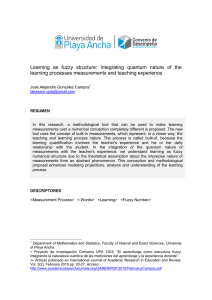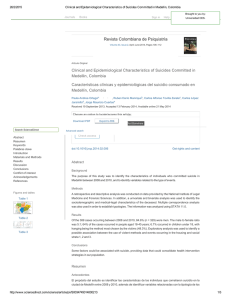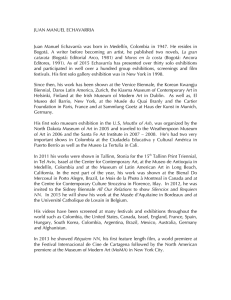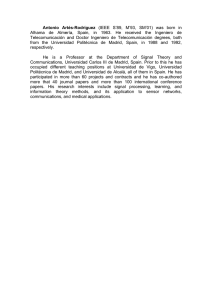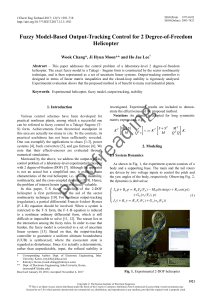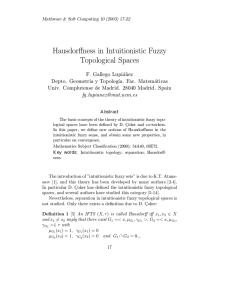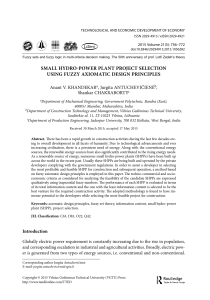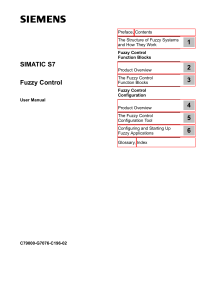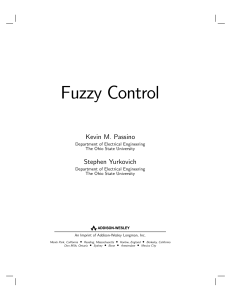GENERATION OF COMPLEX NONLINEAR BENCHMARK
Anuncio
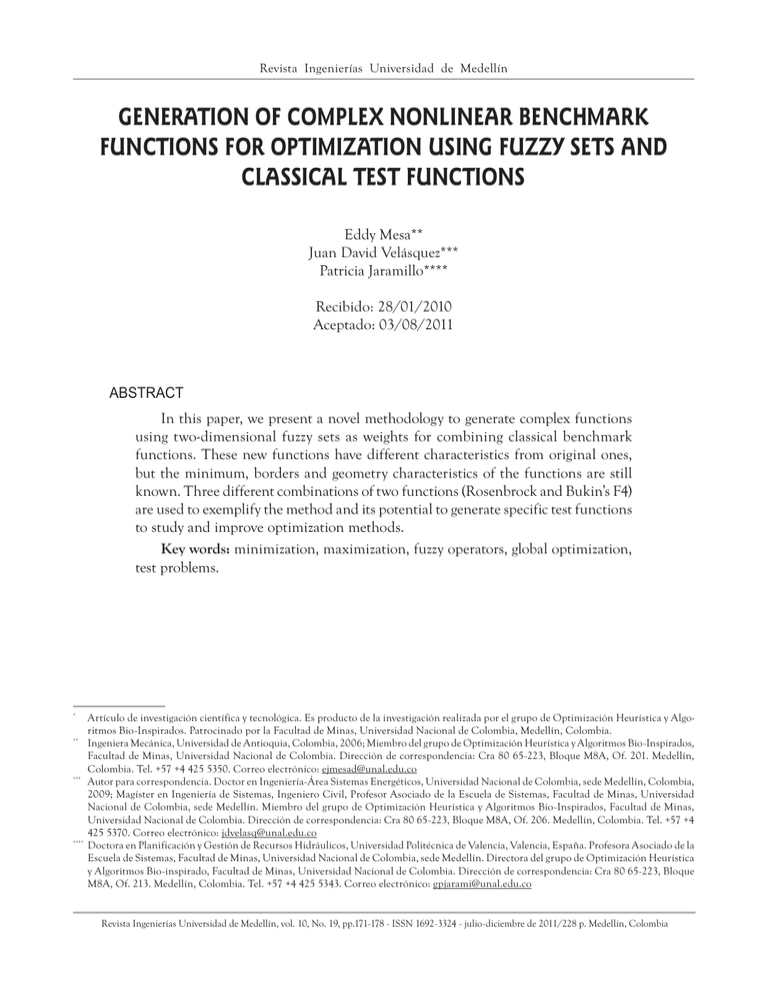
Revista Ingenierías Universidad de Medellín
GENERATION OF COMPLEX NONLINEAR BENCHMARK
FUNCTIONS FOR OPTIMIZATION USING FUZZY SETS AND
CLASSICAL TEST FUNCTIONS
Eddy Mesa**
Juan David Velásquez***
Patricia Jaramillo****
Recibido: 28/01/2010
Aceptado: 03/08/2011
ABSTRACT
In this paper, we present a novel methodology to generate complex functions
using two-dimensional fuzzy sets as weights for combining classical benchmark
functions. These new functions have different characteristics from original ones,
but the minimum, borders and geometry characteristics of the functions are still
known. Three different combinations of two functions (Rosenbrock and Bukin’s F4)
are used to exemplify the method and its potential to generate specific test functions
to study and improve optimization methods.
Key words: minimization, maximization, fuzzy operators, global optimization,
test problems.
Artículo de investigación científica y tecnológica. Es producto de la investigación realizada por el grupo de Optimización Heurística y Algoritmos Bio-Inspirados. Patrocinado por la Facultad de Minas, Universidad Nacional de Colombia, Medellín, Colombia.
** Ingeniera Mecánica, Universidad de Antioquia, Colombia, 2006; Miembro del grupo de Optimización Heurística y Algoritmos Bio-Inspirados,
Facultad de Minas, Universidad Nacional de Colombia. Dirección de correspondencia: Cra 80 65-223, Bloque M8A, Of. 201. Medellín,
Colombia. Tel. +57 +4 425 5350. Correo electrónico: ejmesad@unal.edu.co
*** Autor para correspondencia. Doctor en Ingeniería-Área Sistemas Energéticos, Universidad Nacional de Colombia, sede Medellín, Colombia,
2009; Magíster en Ingeniería de Sistemas, Ingeniero Civil, Profesor Asociado de la Escuela de Sistemas, Facultad de Minas, Universidad
Nacional de Colombia, sede Medellín. Miembro del grupo de Optimización Heurística y Algoritmos Bio-Inspirados, Facultad de Minas,
Universidad Nacional de Colombia. Dirección de correspondencia: Cra 80 65-223, Bloque M8A, Of. 206. Medellín, Colombia. Tel. +57 +4
425 5370. Correo electrónico: jdvelasq@unal.edu.co
**** Doctora en Planificación y Gestión de Recursos Hidráulicos, Universidad Politécnica de Valencia, Valencia, España. Profesora Asociado de la
Escuela de Sistemas, Facultad de Minas, Universidad Nacional de Colombia, sede Medellín. Directora del grupo de Optimización Heurística
y Algoritmos Bio-inspirado, Facultad de Minas, Universidad Nacional de Colombia. Dirección de correspondencia: Cra 80 65-223, Bloque
M8A, Of. 213. Medellín, Colombia. Tel. +57 +4 425 5343. Correo electrónico: gpjarami@unal.edu.co
*
Revista Ingenierías Universidad de Medellín, vol. 10, No. 19, pp.171-178 - ISSN 1692-3324 - julio-diciembre de 2011/228 p. Medellín, Colombia
172
Eddy Mesa; Juan David Velásquez; Patricia Jaramillo
GENERACIÓN DE FUNCIONES BENCHMARK COMPLEJAS
NO LINEALES PARA OPTIMIZACIÓN USANDO CONJUNTOS
DIFUSOS Y FUNCIONES DE PRUEBA CLÁSICAS
RESUMEN
En este artículo se presenta una metodología novedosa para generar funciones
complejas usando conjuntos borrosos bidimensionales como pesos para combinar
funciones clásicas de prueba. Estas nuevas funciones tienen características diferentes
pero el mínimo, los bordes y la geometría de las nuevas funciones se conoce. Tres
combinaciones diferentes de dos funciones (Rosenbrock y F4 de Bukin) se utilizan
para ejemplificar el método y su potencial como generador de funciones de prueba
para estudiar y mejorar métodos de optimización.
Palabras clave: minimización, maximización, operadores difusos, optimización
global, problemas de prueba.
Universidad de Medellín
Generation of complex nonlinear benchmark functions for optimization using fuzzy sets and classical test functions
INTRODUCTION
sets theory to combining well-known to generate
new functions.
The paper is organized as follows. In
Section 2, we review some aspects of classical
test functions. Following, fuzzy set theory is
introduced in Section 3. In Section 4, we state
the description of the proposed methodology.
Next, some examples are presented in Section 5.
Finally, we conclude in Section 6.
1. CLASSICAL TEST FUNCTIONS
The use of well-known test functions is a
common procedure for testing global optimization
algorithms, such that, these functions are
standard literature benchmarks [4-7]. Thus,
researchers are able to compare their results
against other methodologies whose results
are validated and accepted by the scientific
community. Usually, a set of functions is used
to evaluate the behavior of a specific algorithm
in different conditions and to determine their
robustness.
A classical benchmark is the Rosenbrock’s
function (Figure 1):
(
)
2
z = f ( x, y ) = 100 y 2 − x + (1 − x ) (1)
Rosenbrock
2
z
Optimization (maximization or minimization)
of continuous nonlinear functions is an important
problem in sciences, mathematics, engineering
and economics, due to many real-world problems
would be solved in these terms [1]. However,
nonlinear optimization is usually a hard problem;
their difficulties are related to the complexity
of goal function, constrains, topology of the
search region and limitations of the optimization
methodology.
Optimization field has several types of
problems, e.g. combinatorial optimization,
integer optimization, quadratic optimization, and
other; and a universal optimizer does not exist.
Talking about optimizers, Wolpert and Macready
emphasize two points: First, when an optimizer
is designed for a specific problem, it works better
for the problem than other generic optimizer.
Second, there are not harder problems, but there
are different types of problems. It means that
each type of problem has specific characteristics
and it agrees to them an optimizer could have
better performance that another one [2]. I.e.
For developing and comparing new methods,
and for solving real world problems efficiently,
we will want benchmark functions with the
highest number of characteristics available or the
most closed characteristic to the real problem.
Moreover, scientific community provides special
test to compare methods [3].
There are some well-known test functions
[4-7]. They are characterized by their behavior,
which is manifested by the features of the
generated surface, but regularly these functions
are limited to specific characteristics. For example,
the Rosenbrock function has its global optimum
inside of a narrow valley, while in the Bukin’s
F4 function the minimum is located inside
a canon. The aim of this paper is to present a
new methodology for generating or specifying
complex test functions to prove and tune heuristic
optimization algorithms. To do that, we use fuzzy
173
x
y
Figure 1. Rosenbrock’s test function
Source: the authors
Revista Ingenierías Universidad de Medellín, vol. 10, No. 19, pp.171-178 - ISSN 1692-3324 - julio-diciembre de 2011/228 p. Medellín, Colombia
174
Eddy Mesa; Juan David Velásquez; Patricia Jaramillo
BukinF6
• The homogeneity: the characteristic of the
relationship between variables (separable or
no separable).
0.8
0.6
z
0.4
0.2
-2
2
-1
1
x
0
0
1
y
-1
2
-2
Figure 2. Bukin F4 test function.
Source: the authors
It has a global minimum in f (1,1) = 0 . A
standard initial point is x0 = 1 and y0 = −1.2
. DeJong bounded the function to the interval
defined as −2.048 ≤ x ≤ 2.048 to use it in
heuristic optimization [8]. And Yao et al. [9] report
and extend this function to n dimension using
n
the borders in [ −30,30] , which increase the
complexity because it is a bigger search region.
Other classical benchmark is the Bukin’s F4
function (Figure 2):
z = f ( x, y ) = 100 y 2 + 0.01 x + y (2)
Proposed by Bukin [10] with a global
minimum in f (0, 0) = 0 . The standard initial
point x0 = 1 and y0 = 1 , and there are not
borders available.
Test functions are classified in terms of
surface’s features and the primitive functions used
for its construction (or setting-up). Several features
are described as following:
• The dimensionality of the functions definition:
for a fixed number of dimensions or in a general way.
• The modality or ruggedness: quantity of local
optimal (maximum and minimum) points.
They are classified in unimodal functions
with a global minimum and multimodal with
several minimums.
Universidad de Medellín
The above features would have a great
impact in the behavior of a specific optimization
algorithm. For example, it is well known that
gradient based methods have poor behavior
optimizing functions with a huge number of local
optimal points, because they are trapped in a local
optimum and they are not able to escape out.
2. FUZZY SETS AND FUZZY OPERATIONS
In classical sets theory, the membership of
an element to a set is a binary function returning
zero when the element not belongs to the set
and one in otherwise. In fuzzy set theory, the
discrete set {0, 1} for the range of membership
function is changed by the interval [0, 1]. Zero
and one still represents the absolute certainty
of that element belongs or not belongs to the
set. The intermediate values between zero and
one represent uncertainty, such that, partial
membership is allowed [11].
The generalized bell function is a typical
method for specifying the membership function
of a fuzzy set [11]:
1
µ ( x; a, b, c ) =
1+
x−c
b
2a
(3)
Examples of the generalized bell function
with different values for the parameters a, b and c
are shown in Figure 3.
One-dimensional fuzzy sets, as in equation
(3), can be extended to the X×Y plane, using a
fuzzy set for each axis, and then applying any fuzzy
operator. This process is the so-called composition
of fuzzy sets e.g. several bi-dimensional fuzzy sets
would be obtained using the one-dimensional
fuzzy membership functions µ(x; 1, 3, 0) and µ(y;
1, 3, 0) for representing a fuzzy set for each axis,
Generation of complex nonlinear benchmark functions for optimization using fuzzy sets and classical test functions
175
0.8
1.0
Product
0.6
0.4
x
y
0.0
0.2
Membership
z
a=1, b=3, c=0
a=1, b=1, c=0
a=2, b=1, c=2
-2
-1
0
1
2
Figure 4. Composition of fuzzy sets using the product
operator in eq. (4).
x
Figure 3. Membership functions for several parameters.
Source: the authors
Source: the authors
Minimum
and composite it by means of any fuzzy operator;
In Figure 4, we present the fuzzy set obtained
using the product operator defined as:
µ ( x, y ) = µ ( x;1, 3, 0) × µ ( y;1, 3, 0) (4)
z
while the two-dimensional fuzzy set presented
in Figure 5 is obtained using the minimum
operator:
x
µ ( x, y ) = min{µ ( x;1, 3, 0) , µ ( y;1, 3, 0)} (5)
An extensive recompilation of fuzzy operators
is presented in [11] and [12].
3. PROPOSED METHODOLOGY
We propose the generation of new test
functions by means of a weighted sum of
two functions defined by the modeler. Twodimensional fuzzy membership is restricted to
the interval [0, 1], then the operator are used
as the weights in the sum of functions. Thus, if
F1 ( x, y ) and F2 ( x, y ) are classical benchmark test
functions, a new test function would be generated
as:
y
Figure 5. Composition of fuzzy sets using the minimum
operator in eq. (5).
Source: the authors
z = F* ( x, y ) = µ ( x, y ) × H ( F1 ( x, y )) +
[1 − µ ( x, y )] × H ( F2 ( x, y )) (6)
In the previous equation, H () is the
function F ( x, y ) scaled to the interval [0, 1].
The main idea of this methodology is to obtain
new functions with similar characteristics to a
certain problem, with the advantage, over real
problem, of knowing function’s characteristics like
Revista Ingenierías Universidad de Medellín, vol. 10, No. 19, pp.171-178 - ISSN 1692-3324 - julio-diciembre de 2011/228 p. Medellín, Colombia
176
Eddy Mesa; Juan David Velásquez; Patricia Jaramillo
minimums, topology, etc. Also, this methodology
provides a large number of functions with
different characteristics. So, we can obtain a
nearer simulation of the method’s performance
for a specific sort of problems.
4. EXAMPLES
To demonstrate the proposed methodology,
we create three new test function combining
Rosenbrock‘s (see Equation (1)) and Bukin’s
F4 (see Equation (2)) test functions using the
operators described. In the sake of a clear vision
of the functions’ details, we limited the plots in a
2
range in [ −3,3] .
In Figure 6, we present the surface obtained
when µ ( x, y ) is defined as in equation (4);
the obtained function shows that the function
BukinF4’s canon is extended with the features of
the Rosenbrock’s function, while the edges retain
the regularity of the function Bukin F4, but
with the softness of the Rosenbrock’s function. It
would be the first function.
The generated second function is shown
in Figure 7. For this, µ ( x, y ) is defined as in
equation (5), asComposition
in the previous
figure. It still has
using product
a combination of both functions that produce a
different surface, but reminds the same minimum
value: min f (1,1) = f (0, 0) = 0 .
Moreover, complex surfaces may be generated
using only one function too. For example, we use
a rotated version of the original Rosenbrock’s
function as F2 ( x, y ) in Eq. (6). Figure 8 presents
the obtained surface using only the Rosenbrock
function and the product operator. The gradient
∂
z of the generated function is plot in
∂x∂y
Figure 9. One of the criteria of complexity for
optimization problems is the existence of planar
regions on the gradient plot, which is evident in
the figure.
5. CONCLUSIONS
In this paper, we present a novel methodology
to generate new complex test functions for testing,
comparing and tuning global optimization
algorithms. Our methodology is based in the
combination of two two-dimensional classical test
functions using a weighted sum. These weights are
generated by means of a two-dimensional fuzzy
set. Thus, using
only two
initial
test functions,
Composition
using
minimum
z
z
x
y
Figure 6. Composition using the product operator and
the Rosenbrock and BukinF4 test functions.
Source: the authors
Universidad de Medellín
x
y
Figure 7. Composition using the product operator and
the Rosenbrock and Bukin’s F4 test functions.
Source: the authors
Generation of complex nonlinear benchmark functions for optimization using fuzzy sets and classical test functions
many complex surfaces can be generated changing
the parameters and composition operators used
for generating the two-dimensional fuzzy sets.
Although several topologies could be generated,
the characteristics of the function are still known,
so the new function remains a good benchmark.
Composition using minimum
177
REFERENCES
[1] P. M. Pardalos, y M. G. C. Resende, ed, “Handbook of
Applied Optimization,” New York: Oxford University
Press, 2002
[2] W. G. Macready, y D. H. Wolpert, “What makes an
optimization problem hard?,” Complexity, vol. 5, pp.
40-46, 1996.
z
[3] S. Das y P. N. Suganthan. “Problem Definitions and Evaluation Criteria for CEC 2011 Competition on Testing
Evolutionary Algorithms on Real World Optimization
Problems”. Singapore, 2010. Available: http://web.
mysites.ntu.edu.sg/epnsugan/PublicSite/Shared%20
Documents/CEC%202011-%20RWP/Tech-Rep.pdf
[4] W. Hock y K. Schittkowski. “Test Examples for Nonlinear Programming Codes”, Lecture Notes in Economics and Mathematical Systems, vol. 187, Springer
1981.
x
[5] J.J. Moré, et al. “Testing Unconstrained Optimization
Software”, ACM Transactions on Mathematical Software,
vol. 7, no. 1, pp. 17-41, 1981.
y
Figure 8. Composition using the product operator and
the Rosenbrock test function rotated
Source: the authors
Derivate
[6] I. Bongartz, et al. “CUTE: Constrained and Unconstrained Testing Environment”, ACM Transactions on
Mathematical Software, vol. 21, no. 1, pp. 123-160, 1995.
[7] N. I. M. Gould, et al. “CUTEr (and SifDec): a Constrained and Unconstrained Testing Environment,
revisited”, ACM Transactions on Mathematical Software,
vol. 29, no. 4, pp. 373-394, 2003.
[8] K. A. De Jong. “Analysis Of The Behavior Of A Class
Of Genetic Adaptive System”. University of Michigan.
Michigan, Technical Report No. 185, 1975
1.0
[9] X. Yao, Y. Liu, y G. Lin. “Evolutionary programming made
faster”, IEEE Transactions on Evolutionary Computation.
Vol. 3, no. 2, pp. 82-102,1999
0.5
z
0.0
-0.5
-1.0
-2
2
-1
1
x
0
0
1
y
-1
2
-2
Figure 9. Derivate for the function of Figure 8.
Source: the authors
[10] A. D. Bukin. “New Minimization Strategy For NonSmooth Functions”, Budker Institute of Nuclear
Physics preprint Novosibirsk, BUDKER-INP-1997-79,
1997
[11]J.-S.R, Jang, et al., Neuro-Fuzzy and Soft Computing: A
computational approach to learning and machine intelligence.
Prentice Hall, 1996.
[12] N. Kasabov. Foundations of Neural Networks, Fuzzy Systems, and Knowledge Engineering, 2nd edn, Massachusetts
Institute of Technology, 1998.
Revista Ingenierías Universidad de Medellín, vol. 10, No. 19, pp.171-178 - ISSN 1692-3324 - julio-diciembre de 2011/228 p. Medellín, Colombia
